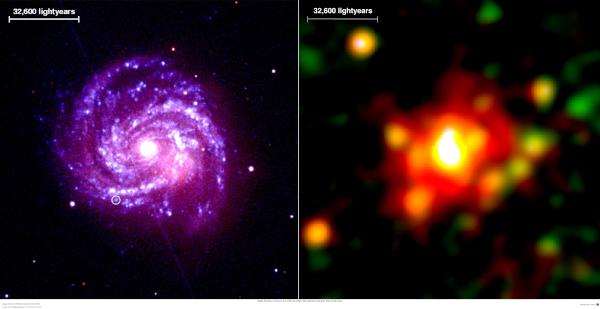XMM-Newton's Views of SN 1979C in M100: The supernova that just won't fade away

Minimum credit line: Image courtesy of Stefan Immler (NASA GSFC) and ESA. (for details, see Conditions of Use).
Credit: ESA/XMM-Newton, CC BY-SA 3.0 IGO
The image above can be displayed at full size and may be downloaded by clicking the image above.
| About this Image |
|---|
These false-colour images show the spiral galaxy M100, also known as NGC 4321, and within the galaxy the supernova SN 1979C. On the left is the image of M100 in the UV/optical, taken with XMM-Newton's Optical Monitor (OM) camera, and on the right the galaxy is shown on the same scale but imaged in the X-ray with XMM-Newton's MOS cameras. M100 is in the Virgo cluster of galaxies, 56 million light years from Earth. The overall appearance of the galaxy is strikingly different in the X-ray compared to the UV/optical. The OM image clearly shows the spiral structure of the galaxy whilst in the X-ray image this structure is not visible and instead the galaxy X-ray luminosity tends to fall off from the galaxy centre, with some bright regions. The supernova 1979C is shown circled in the UV/optical image, and can be seen as an orange spot to the lower left of the galactic centre (which appears white) in the X-ray image. This particular supernova is curious because it is still just as bright in the X-ray as when it was observed by ROSAT in 1995, six years before the XMM-Newton observation. Normally objects of this type would be expected to dim significantly over time. In the OM image the false colouring was done using images taken with three fiters: the B filter (4340 Å), the U filter (3440 Å) and the UVW1 (2910 Å). In the X-ray image soft (0.3-1.5 keV) X-rays are shown in red, medium (1.5-4 keV) in green and hard (4-10 keV) in blue. The hardest X-rays are emitted from the galactic core, but are not seen as pure blue because there are also medium and soft X-rays emitted from that location.
Investigator(s): S. Immler, R. A. Fesen, S. D. Van Dyk, K. W. Weiler, R. Petre, W. H. G. Lewin, D. Pooley, W. Pietsch, B. Aschenbach, M. C. Hammell, G. C. Rudie
| For More Information |
|---|
- Read the Press Release
- Read the Journal article
- Detailed description of this image
- Query XSA archive for XMM-Newton data in the field of SN 1979C
- Astronomical database entries for SN 1979C;
- Query NED for more images about SN 1979C
- Query SIMBAD for more SN 1979C data
- For unfamiliar terms, visit the XMM-Newton Astronomical Glossary
| Instrument | EPIC MOS | ||
| Observing Mode | Full Frame | ||
| Filter | Medium | ||
| Date of Observation | 2001-12-28 | ||
| Image size | 9.00 x 9.00 arcmin | ||
| Detailed Caption | Two false-colour images of the spiral galaxy M100 (also known as NGC 4321) are shown, with the
supernova SN 1979C visible. The galaxy is in the Virgo galaxy cluster, 56
million light years away. On the left the galaxy is shown as seen in the
UV/optical by XMM-Newton's OM, and on the right as seen in the X-ray by
XMM-Newton's MOS cameras. The supernova can be seen inside a white circle in the UV/optical image, and as an orange spot to the bottom left of the galactic centre in the
X-ray image. This supernova is of particular interest because its X-ray
luminosity is not diminishing as would be expected, it is still as luminous in
the X-ray as when it was detected by ROSAT in 1995, six years previously. Usually the
X-ray and radio luminosities of X-ray supernovae would fall off with time
governed by a power law. This has lead scientists to speculate about the
mechanism producing this long-term high luminosity. When a supernova explosion
occurs, the interaction of the shock and ejecta travelling outwards from the
central star with the surrounding circumstellar medium produces X-ray emission.
It is suggested by the investigators that the progenitor star had a high mass
loss rate and a large amount of mass was deposited as circumstellar material.
This has lead to large amounts of shocked circumstellar material after the
supernova went off, hence causing the high luminosity. This is supported by
findings of high luminosity seen by the OM in the U-band from Mg II and
UVW1-band from [Ne III], which indicates significant interaction with
circumstellar material. One other supernova, SN 1978K, has also been observed
to have an unusual lack of decrease in its luminosity, similar to SN 1979C.
The data used to create these images was taken on December 28th 2001. The MOS instruments took exposures through the medium filter in full frame mode, and the total exposure time after cleaning was 27.1 ks. The OM data was taken through three filters: the B filter (4340 Å) for 2.0 ks, the U filter (3440 Å) for 1.8 ks, and the UVW1 (2910 Å) for 1.9 ks. In the X-ray image the false-colouring is divided into the following energy bands: soft (0.3-1.5 keV) X-rays are shown in red, medium (1.5-4 keV) in green and hard (4-10 keV) in blue. |
||
| Alternate Resolutions | (Help) |
|---|
This image is available in the following downloadable versions: Higher resolution versions of this image may be available, please contact the XMM-Newton HelpDesk.
Search the Image Gallery
To search the Image Gallery for a particular object, fill in the object name in the box below and click the Submit button.To search the Image Gallery for other images, fill in any of the fields below and click the Submit button.
For more search options, please use our Advanced Search form.